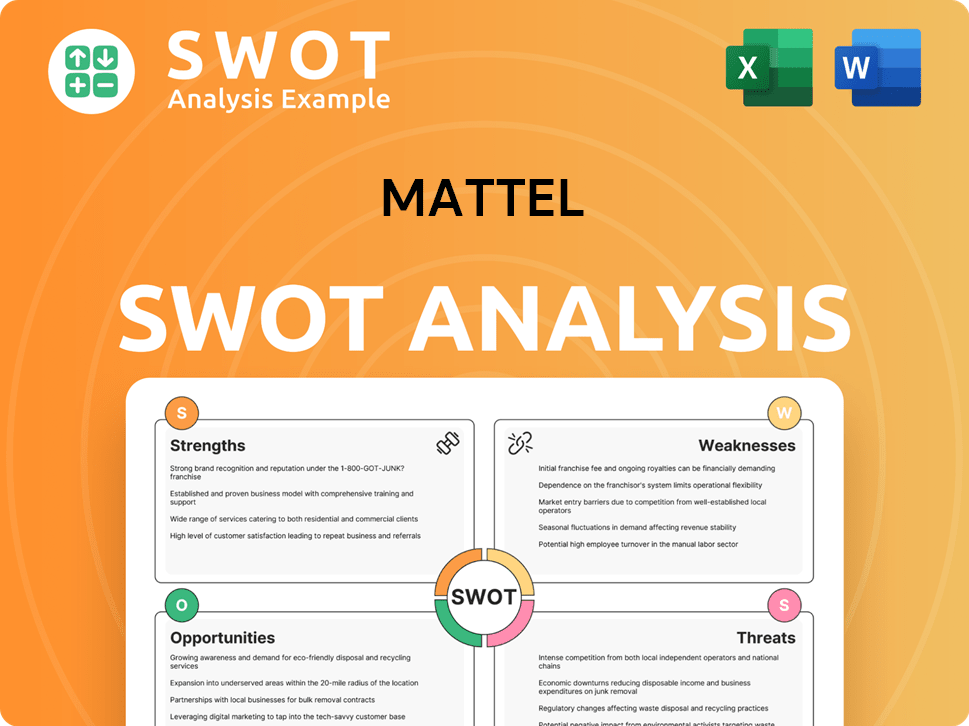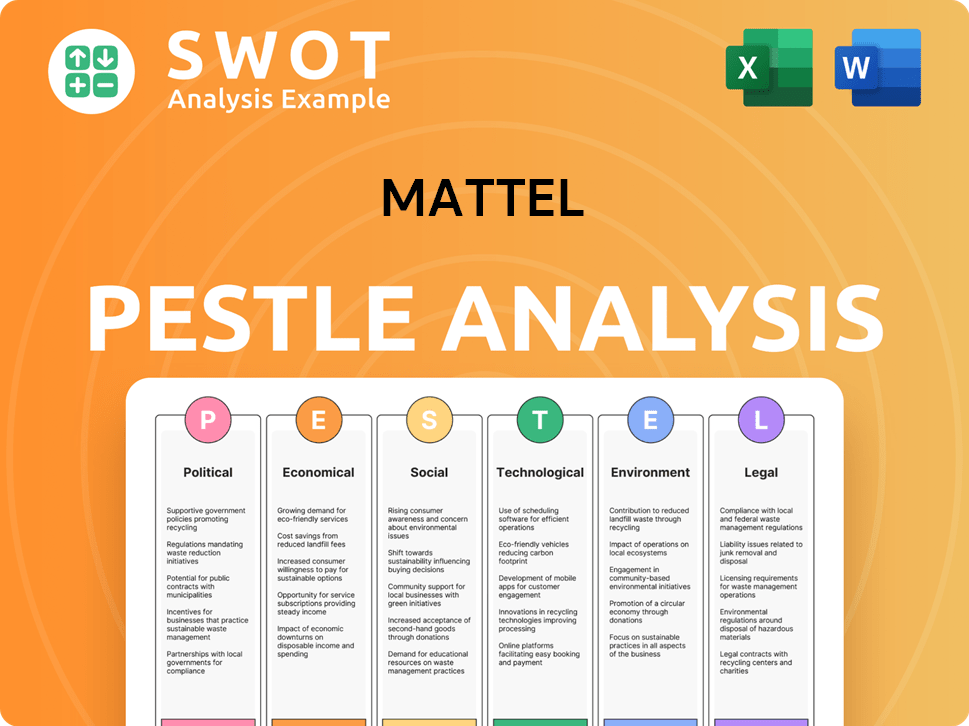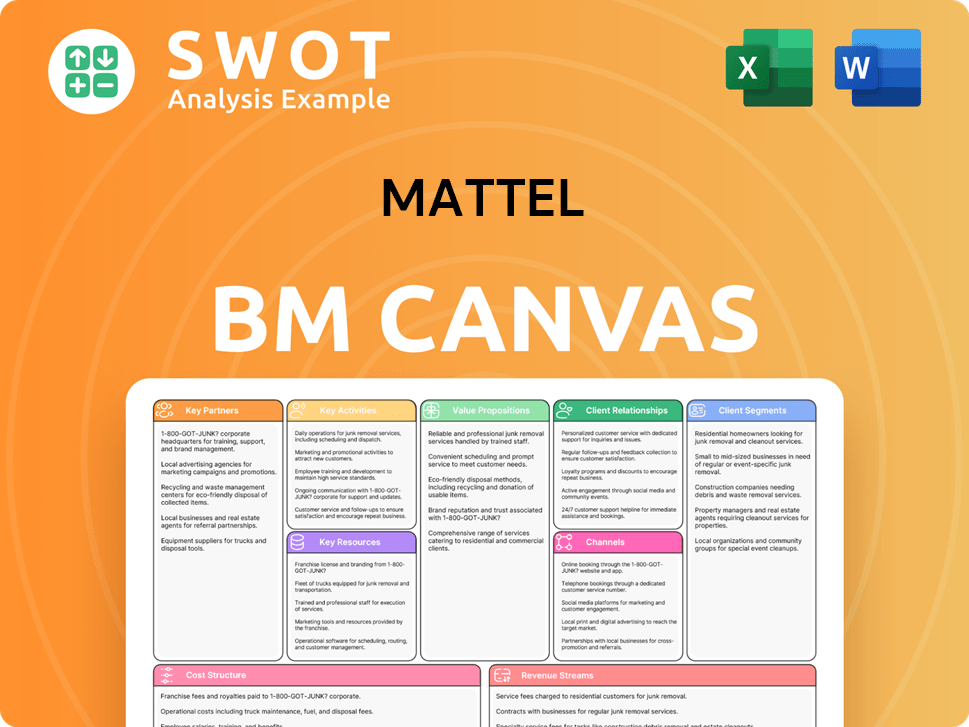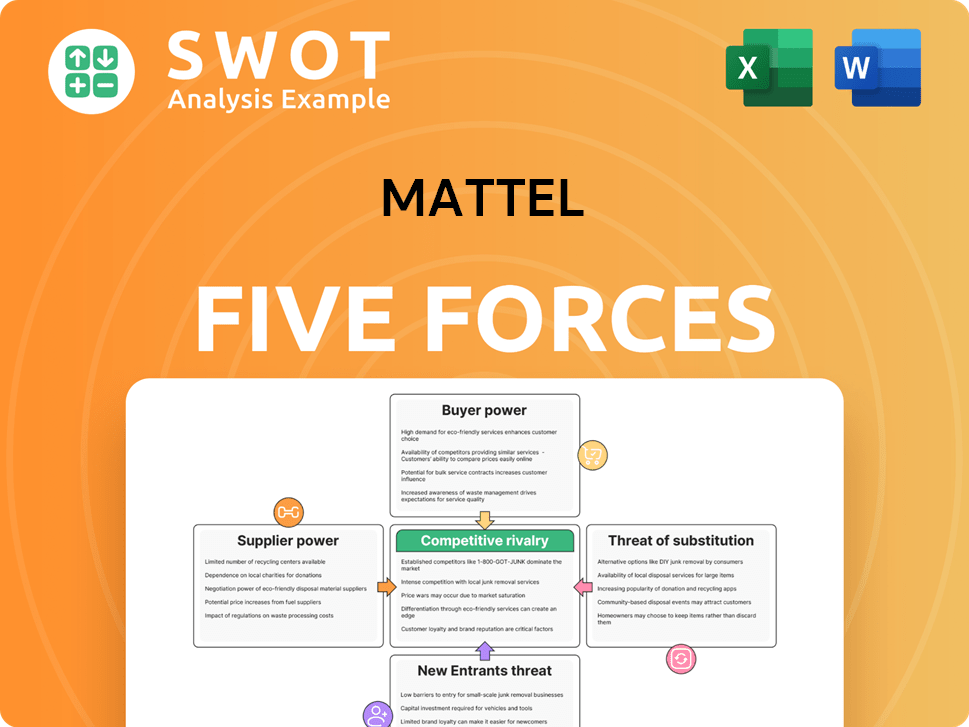Mattel Bundle
How Did the Barbie Movie Revolutionize Mattel's Sales?
The phenomenal success of the Barbie movie in 2023 wasn't just a box office triumph; it was a masterclass in content-driven marketing, fundamentally reshaping how the Mattel SWOT Analysis views its sales and marketing strategy. This success highlights the critical need for adaptability and innovation in the toy industry. Founded in 1945, Mattel's journey from a garage business to a global entertainment leader is a testament to its evolving strategies.

This analysis will explore Mattel's contemporary Mattel sales strategy and Mattel marketing strategy, examining its shift from traditional retail to a sophisticated omnichannel approach. We'll dissect its strategic brand positioning, key campaigns like the Barbie movie, and how Mattel continues to dominate the market. Understanding Mattel's Mattel business model offers valuable insights into the toy industry marketing landscape.
How Does Mattel Reach Its Customers?
The sales channels of the company are a critical component of its overall sales and marketing strategy, ensuring its products reach a wide audience. This strategy involves a combination of online and offline approaches, leveraging both traditional retail and e-commerce platforms. The company's ability to adapt and evolve its distribution methods is key to maintaining its market position in the competitive toy industry.
The company focuses on a multi-channel approach to maximize its market reach. This includes strategic partnerships with major retailers and a growing emphasis on direct-to-consumer (DTC) sales. By diversifying its distribution networks, the company aims to meet the evolving needs of consumers and optimize its sales performance.
The company's sales strategy is designed to address the dynamic nature of the toy market. This includes an emphasis on digital channels and strategic alliances to enhance its brand presence and sales reach. For more insights into the company's financial structure, you can explore the information provided at Owners & Shareholders of Mattel.
Offline retail channels remain a cornerstone of the company's sales strategy, particularly through partnerships with major global retailers. These physical stores provide a crucial platform for showcasing products and reaching a broad customer base. The company's strong presence in traditional retail is essential for capturing market share and maintaining brand visibility within the toy industry marketing landscape.
The company has significantly expanded its e-commerce operations, recognizing the growing importance of online sales. Online sales accounted for 15.6% of the total distribution channels in 2024. This includes sales through its website and various e-commerce platforms. This strategic shift towards digital channels allows the company to adapt to changing consumer behaviors and boost profitability.
The company is actively developing its direct-to-consumer (DTC) internet business. This approach allows the company to build stronger relationships with consumers and gain more control over the customer experience. By focusing on DTC, the company aims to improve profitability and gather valuable consumer insights, which is a key element of its sales and marketing plan.
Key partnerships and licensing agreements are integral to the company's sales strategy. Collaborations with major entertainment companies, such as Universal and WWE, expand product lines and leverage existing fan bases. These strategic alliances enhance market dominance and drive future growth, providing a competitive advantage in the toy market.
The company's sales channels are designed to ensure broad market coverage and adapt to changing consumer preferences. The company's distribution strategy is a key component of its overall business model.
- Offline Retail: Major retailers like Walmart contributed significantly to sales, accounting for 22.3% of global sales in 2024.
- Online Sales: E-commerce represented 15.6% of total distribution channels in 2024.
- DTC Focus: Increasing emphasis on direct-to-consumer sales for enhanced customer engagement.
- Strategic Partnerships: Collaborations with entertainment companies to expand product lines and reach.
Mattel SWOT Analysis
- Complete SWOT Breakdown
- Fully Customizable
- Editable in Excel & Word
- Professional Formatting
- Investor-Ready Format

What Marketing Tactics Does Mattel Use?
The marketing tactics employed by the company are multifaceted, integrating both digital and traditional approaches to enhance brand visibility and drive sales. This strategy includes a strong emphasis on digital platforms, leveraging social media and search engine optimization (SEO) to reach a wide audience. The company also invests in traditional advertising methods to create a comprehensive marketing approach.
A key element of the company's marketing strategy is its data-driven approach, which uses market research and customer insights to tailor products and stay ahead of market trends. This includes segmenting the target audience by age and interests to create toys that resonate with consumers. This approach helps in creating toys that resonate deeply with consumers and drive engagement and sales.
The company's adaptability to emerging trends, such as the projected $24 billion global smart toys market by 2025, is crucial for its continued success. This ensures that the company remains relevant and competitive in a rapidly evolving market.
The company heavily utilizes social media platforms like Facebook, Instagram, and YouTube to connect with its target audience and generate buzz. It also prioritizes SEO to enhance online visibility. The company invested approximately $22.6 million in influencer marketing campaigns in 2022.
Traditional methods, including TV, radio, and print advertising, are still used to create a multifaceted approach that strengthens brand loyalty. The company famously advertised through the Mickey Mouse Club in the 1950s. This approach allows for a wider reach and reinforces brand recognition.
Market research and customer insights are used to tailor toys for specific markets and stay ahead of trends. The company segments its target audience by age and interests, catering to specific growth stages and preferences. This approach emphasizes quality, play value, and competitive pricing.
The company has invested $78 million in digital toy technology development for 2024, focusing on augmented reality play experiences, mobile app-connected toys, smart device integration, and virtual play platforms. This digital transformation extends to expanding into digital toys, games, and apps.
The company’s strategy includes segmenting its target audience by age and interests, catering to specific growth stages and preferences. This targeted approach helps in creating toys that resonate deeply with consumers, driving engagement, and boosting sales. See the Target Market of Mattel for more details.
The company’s adaptability to emerging trends, such as the projected $24 billion global smart toys market by 2025, is crucial for its continued success. This forward-thinking approach ensures that the company remains competitive and relevant in a dynamic market.
The company's successful Mattel sales strategy is built on a foundation of diverse Mattel marketing strategy tactics. The focus is on reaching consumers through various channels and adapting to evolving consumer preferences. The core of the Mattel business model is to create toys that resonate with consumers and drive sales.
- Leveraging Social Media: Utilizing platforms like Facebook, Instagram, and YouTube to generate buzz and connect with the target audience.
- Search Engine Optimization (SEO): Enhancing online visibility through SEO to improve search rankings and attract more customers.
- Influencer Marketing: Collaborating with influencers and toy reviewers to increase brand awareness and reach a wider audience.
- Traditional Advertising: Employing TV, radio, and print advertising to maintain brand recognition and reach a broad demographic.
- Data-Driven Approach: Using market research and customer insights to tailor toys for specific markets and stay ahead of trends.
- Targeted Segmentation: Segmenting the target audience by age and interests to create toys that resonate deeply with consumers.
Mattel PESTLE Analysis
- Covers All 6 PESTLE Categories
- No Research Needed – Save Hours of Work
- Built by Experts, Trusted by Consultants
- Instant Download, Ready to Use
- 100% Editable, Fully Customizable

How Is Mattel Positioned in the Market?
Mattel's brand positioning centers on delivering quality and play value, using a diverse portfolio of iconic brands like Barbie and Hot Wheels. The core message focuses on inspiring generations to explore the wonder of childhood and reach their full potential. This is visually represented through recognizable logos and a tone of voice that emphasizes imagination and fun.
The company strategically targets children, parents, and adult collectors, leveraging nostalgia, innovation, and a commitment to inclusivity and sustainability. For example, the Barbie brand has evolved to promote diversity and reflect societal shifts, enhancing consumer loyalty. This approach is crucial for its Mattel sales strategy.
Brand consistency is maintained across all channels, from physical toys to digital content and live experiences. This adaptability, combined with ongoing investment in product innovation, demonstrates the company's ability to evolve beyond traditional toy manufacturing. This evolution towards fan-driven engagement helps nurture fandoms and maintain relevance, supporting its Mattel marketing strategy.
Mattel's brand identity is built on quality and play value, with a focus on iconic brands. The company's visual identity is consistent across all platforms, ensuring brand recognition. This strong identity helps in its Mattel brand positioning.
Mattel's target audience includes children, parents, and adult collectors. The company uses nostalgia, innovation, and inclusivity to appeal to these diverse groups. Understanding its target market is key to its sales and marketing plan.
Mattel uses a variety of marketing channels, including physical toys, digital content, and live experiences. The company adapts to shifts in consumer sentiment by investing in product innovation. This multi-channel approach supports its Toy industry marketing efforts.
Mattel's competitive advantage comes from its iconic brands and ability to adapt to changing trends. The company focuses on product innovation and expanding into entertainment and digital experiences. This strategic approach helps maintain its market share.
Mattel's strategies include product innovation, brand consistency, and expanding into new markets. The company focuses on adapting to consumer trends and leveraging digital platforms. For more details, see the Growth Strategy of Mattel.
- Product Innovation: Continuously developing new toys and experiences.
- Brand Consistency: Maintaining a consistent brand message across all channels.
- Digital Engagement: Utilizing digital platforms and social media.
- Sustainability: Introducing sustainable products to meet consumer demand.
Mattel Business Model Canvas
- Complete 9-Block Business Model Canvas
- Effortlessly Communicate Your Business Strategy
- Investor-Ready BMC Format
- 100% Editable and Customizable
- Clear and Structured Layout

What Are Mattel’s Most Notable Campaigns?
The success of campaigns is crucial to the Mattel sales strategy. Recent campaigns, particularly those tied to the 2023 Barbie movie, have significantly boosted the brand's visibility and sales. This content-driven marketing approach focuses on engaging customers as fans, which is a key element of their Mattel marketing strategy.
Mattel's business model includes consistently running campaigns for its diverse portfolio. Hot Wheels continues to perform strongly, and the company is expanding its entertainment offerings through films and TV shows for various brands. This multi-platform strategy is designed to build long-term customer loyalty and engagement across different segments.
The marketing efforts extend beyond individual brands, with strategic partnerships and new product lines contributing to overall growth. These campaigns are designed to extend fan engagement across multiple platforms, building long-term loyalty and driving sales. The company's focus on entertainment and product innovation is a key driver of its market position.
The 2023 Barbie movie campaign revitalized the Barbie brand. It incorporated nostalgia with modern themes of empowerment and inclusivity. The campaign used film, digital media, and strategic collaborations to reach a wide audience. The movie became the highest-grossing film of 2023.
Hot Wheels continues to be a strong performer, with expectations for another record year. The brand benefits from ongoing marketing efforts and product innovations. These campaigns focus on maintaining and expanding the brand's appeal to both children and collectors.
Mattel is expanding its entertainment offerings with new films and TV shows. This includes brands like Hot Wheels, Matchbox, UNO, and Masters of the Universe. As of February 2025, 16 Mattel films were in development or production.
New product lines and strategic partnerships, such as the F1 partnership for Vehicles and global expansion of WWE, drive sales. Mattel Television Studios premiered 14 series and specials in 2024, including Barney's World, as part of a franchise relaunch.
Mattel's marketing strategies leverage content-driven campaigns and strategic partnerships. The company focuses on creating engaging content and expanding its brand presence across multiple platforms. This approach aims to increase brand visibility and drive sales growth.
- Content-Driven Marketing: Focus on creating compelling content, as seen with the Barbie movie.
- Multi-Platform Engagement: Expanding content across film, TV, and digital media.
- Strategic Partnerships: Collaborating with other brands to reach new audiences.
- Product Innovation: Launching new product lines to cater to evolving consumer trends.
Mattel Porter's Five Forces Analysis
- Covers All 5 Competitive Forces in Detail
- Structured for Consultants, Students, and Founders
- 100% Editable in Microsoft Word & Excel
- Instant Digital Download – Use Immediately
- Compatible with Mac & PC – Fully Unlocked

Related Blogs
- What are Mission Vision & Core Values of Mattel Company?
- What is Competitive Landscape of Mattel Company?
- What is Growth Strategy and Future Prospects of Mattel Company?
- How Does Mattel Company Work?
- What is Brief History of Mattel Company?
- Who Owns Mattel Company?
- What is Customer Demographics and Target Market of Mattel Company?
Disclaimer
All information, articles, and product details provided on this website are for general informational and educational purposes only. We do not claim any ownership over, nor do we intend to infringe upon, any trademarks, copyrights, logos, brand names, or other intellectual property mentioned or depicted on this site. Such intellectual property remains the property of its respective owners, and any references here are made solely for identification or informational purposes, without implying any affiliation, endorsement, or partnership.
We make no representations or warranties, express or implied, regarding the accuracy, completeness, or suitability of any content or products presented. Nothing on this website should be construed as legal, tax, investment, financial, medical, or other professional advice. In addition, no part of this site—including articles or product references—constitutes a solicitation, recommendation, endorsement, advertisement, or offer to buy or sell any securities, franchises, or other financial instruments, particularly in jurisdictions where such activity would be unlawful.
All content is of a general nature and may not address the specific circumstances of any individual or entity. It is not a substitute for professional advice or services. Any actions you take based on the information provided here are strictly at your own risk. You accept full responsibility for any decisions or outcomes arising from your use of this website and agree to release us from any liability in connection with your use of, or reliance upon, the content or products found herein.